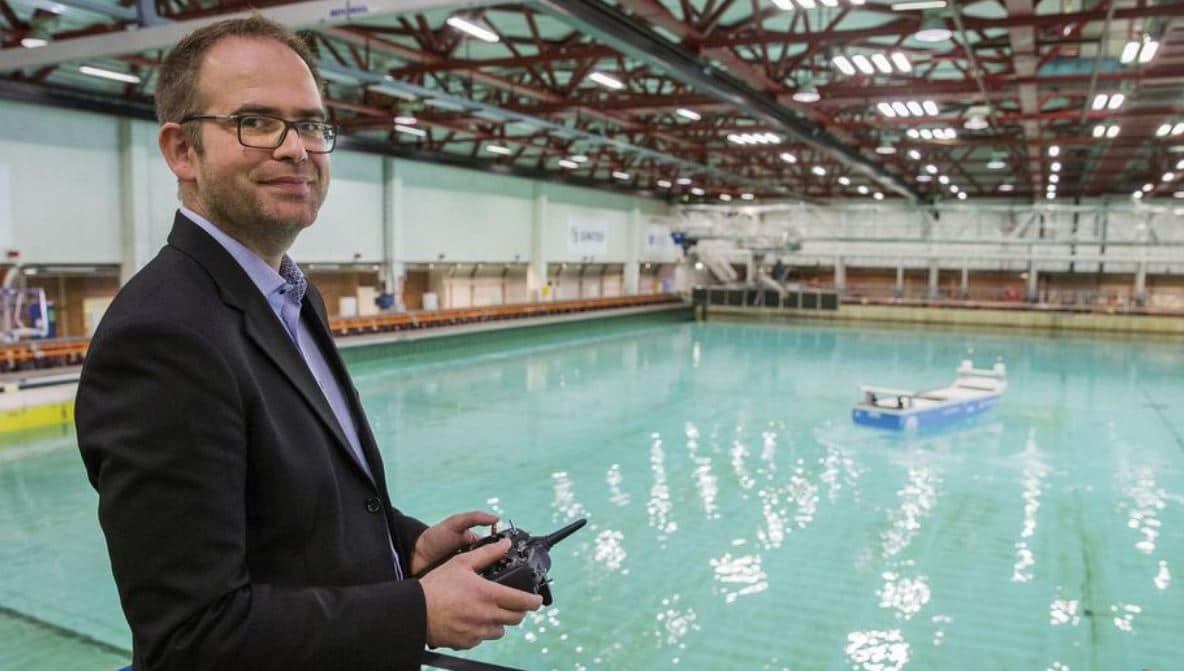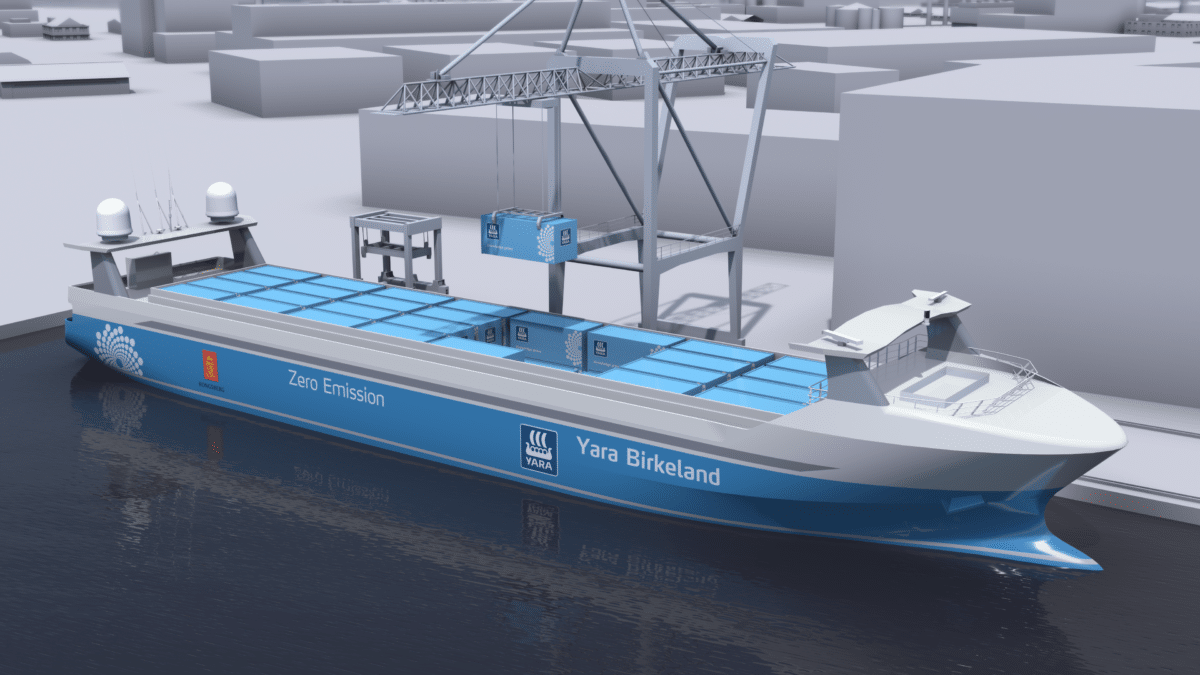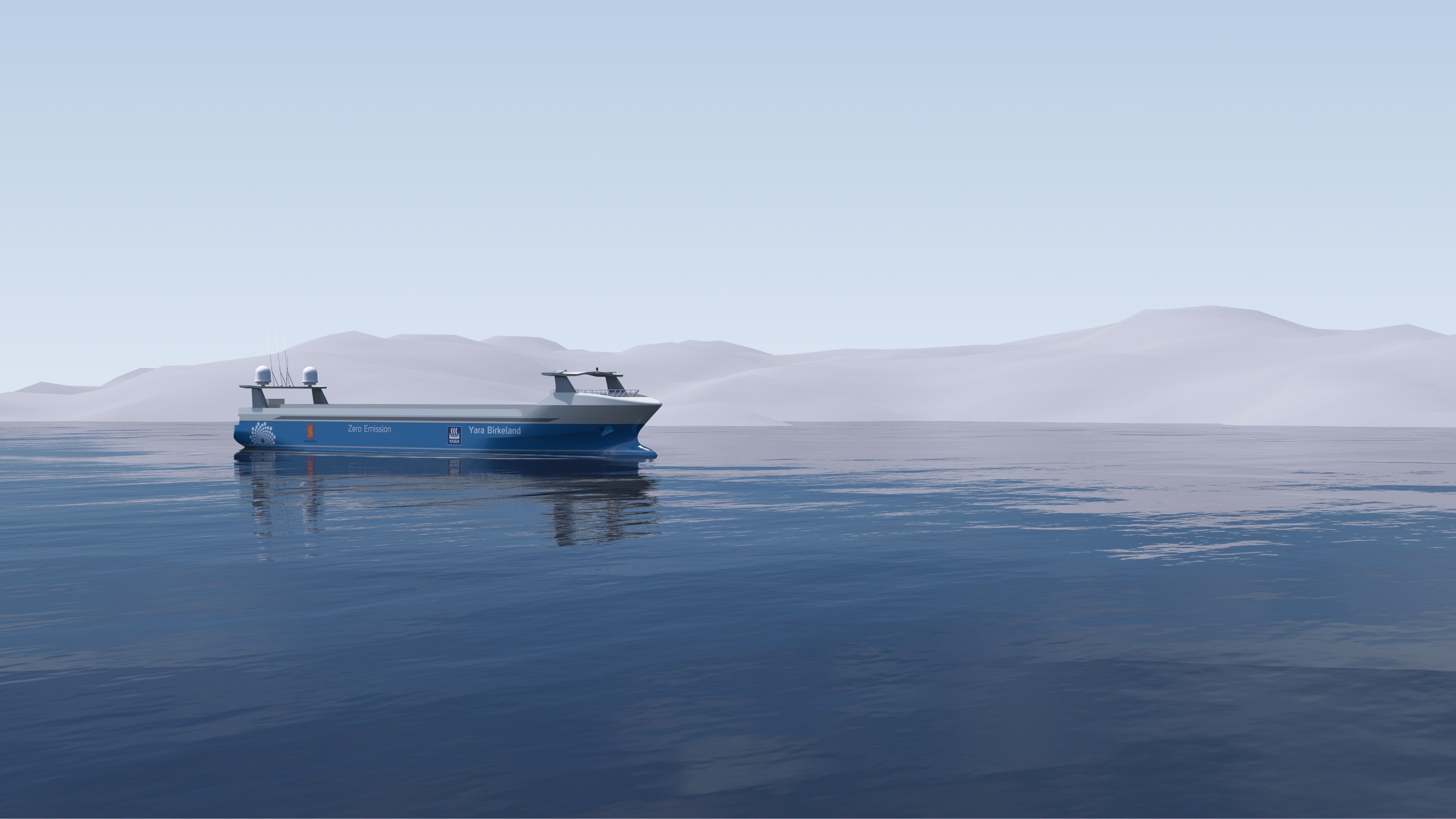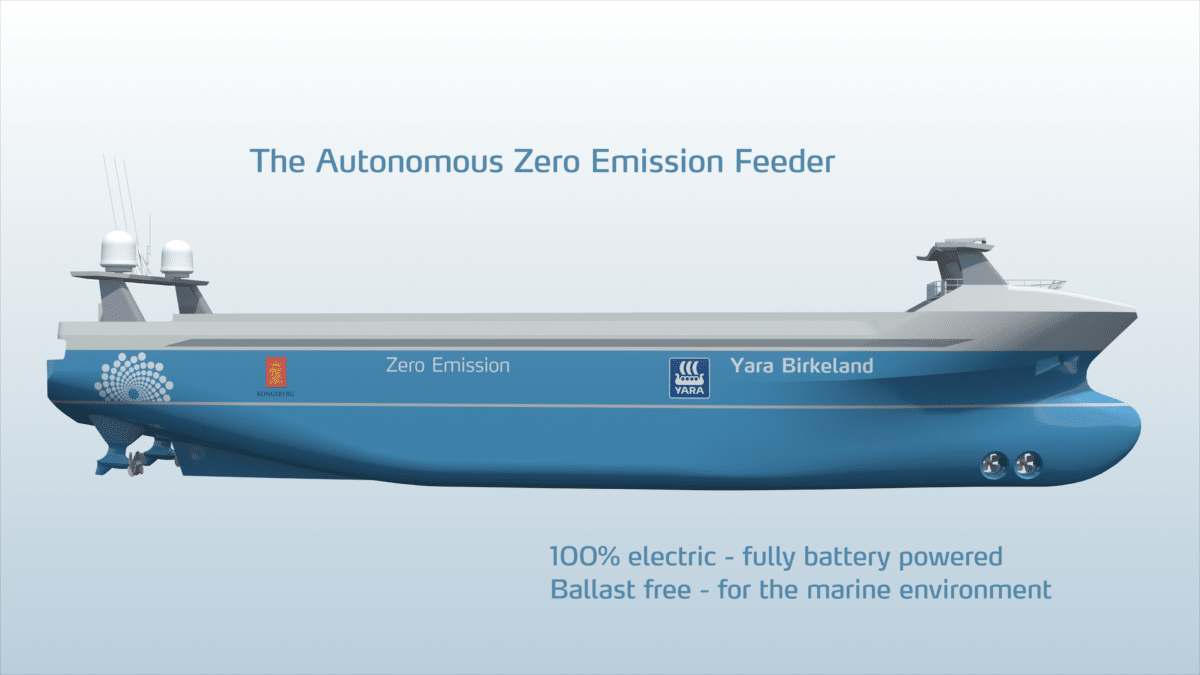
Bjørn Tore Orvik introduces Yara Birkeland, a.k.a. the Tesla of the Seas. [Photo: Christine Schefte]
Bjørn Tore Orvik, Yara International, Oslo, Norway
Imagine a container ship that didn’t guzzle fuel and generate emissions equal to millions upon millions of cars. While carbon dioxide emissions from shipping are on the rise globally, Norwegian chemical company Yara International is doing its part to plan for a cleaner future.
The International Maritime Organization estimates carbon dioxide emissions from shipping were equal to 2.2% of the global human-made emissions in 2012, expecting them to rise 50 to 250% by 2050 if no action is taken.
Fortunately, action is being taken, at least on some local levels. In May 2017, Yara announced a partnership with global maritime technology company Kongsberg Maritime to build a fully electric, autonomous, open-top container ship. That’s right—fully autonomous, operated by an innovative system of sensors, cameras, and radar to get 100 containers of NPK fertilizer from one Norwegian city to another across the fjord each day, replacing 40,000 diesel-powered truck trips each year.
“Yara Birkeland is a game-changer that will set a new standard in the maritime sector,” says Bjørn Tore Orvik, project manager for Yara Birkeland. “It’s also a commercial solution that will help the world deliver on the climate goals as set forth in the Paris agreement.” It was Orvik’s idea to build an autonomous, electric vessel, and he sees potential to shake up the entire industry. The Norwegian government itself has allocated roughly 133 million NOK ($16 million USD) in funds, while the total cost of this project’s investment (vessel and quayside equipment) is approximately 400 million NOK, or $49 million USD.
The project is still in its early stages. The ship’s designer, Marin Teknikk, was selected in June 2017. In September, a six-meter-long, 2.4-ton model of the final design was revealed and its capabilities were tested in water at SINTEF Ocean‘s 80-meter test tank facility in Trondheim, Norway. In early 2019, the Yara Birkeland will set sail—at first as a manned operation, before an unmanned and fully autonomous operation is tested in 2020. Kongsberg is responsible for developing and delivering all key technologies on Yara Birkeland, including the sensors and integration required for remote and autonomous operations, in addition to the electric drive, battery, and propulsion control systems.
We recently took some time to speak with Orvik and the Yara Birkeland crew to find out more about how the “Tesla of the Seas” is set to change the industry as we know it.

The Yara Birkeland model is seen during testing in an indoor tank. [Photo: Courtesy of Yara Birkeland]
gb&d: How was this idea born? Why a fully electric, autonomous container ship?
Bjørn Tore Orvik: Yara is looking for every way to reduce emissions and make our production and logistics environmentally friendly. In Porsgrunn, Norway, we ship about 100 containers with fertilizer every day by truck to regional shipping hubs in Larvik (20 kilometers away) and Brevik (25 kilometers away). Last year we started looking into using maritime transport as an alternative to these truck journeys through densely populated areas. In dialogue with the leading maritime technology company Kongsberg, we soon agreed that together we had the opportunity to realize a game-changer within short sea shipping. We are proud to be a pioneer in the race toward cleaner and more efficient commercial transportation.
gb&d: What has surprised you about this process so far?
Orvik: It’s been a very positive process with great collaboration with partners Kongsberg Maritime and Marin Teknikk. One of the interesting things about this project is there are currently no national or international regulations covering autonomous ships. The Norwegian Maritime Authority and the Norwegian Coastal Administration has participated in the project from day one, with the aim of establishing a national regulatory framework, so that autonomous vessels are allowed to sail in Norway. Digitalization and electrification has entered most industries. Yara Birkeland is a game-changer in the maritime sector, and we believe that in the near future we will see several vessels performing autonomous operations.

The ship will eliminate 40,000 truck journeys per year, reduce dust and local pollution, reduce CO2 emissions, and improve road safety in densely populated areas. [Rendering: Courtesy of Yara Birkeland]
gb&d: I understand that the ship will make short trips between Porsgrunn and Larvik/Brevik, but will longer trips occur in future?
Orvik: The plan for Yara Birkeland is to sail between Porsgrunn and Larvik/Brevik in Norway. We believe we will also see other autonomous ships be built that could travel in the deep-sea segment. But the largest potential when it comes to sustainable operations is within short sea shipping and inland waterways.
gb&d: What is the ultimate goal of this project?
Orvik: Zero emission fertilizer production. We believe innovation is the key to solve the challenges facing the world, transforming bright ideas into business value.
gb&d: Walk us through just how Yara Birkeland will be able to operate without a crew.
Orvik: An autonomous ship will be equipped with advanced sensors, cameras, and different types of radars. Tests that have been made show how the ship sees and recognizes regular small boats, windsurfers, and kayakers. The ship also sees objects the size of a seagull when there is little sea. This is possible by combining multiple types of radar technology and camera. The autonomous ship relies on common laws and regulations for safe navigation in the same way as any other ship. It’s equipped with several sensors that will see both small and large boats. The ship will attempt to drive outside or stop if a small boat comes on a collision course. Although the ship is not manned, it will be possible to call the ship on the VHF to notify of reduced maneuverability, such as failure with the engine or the sail, tow, and so on. It would be possible to contact the ship’s operation center.

[Photo: Courtesy of Yara Birkeland]
gb&d: What about docking?
Orvik: We will rebuild the docking area to provide equipment for automatic mooring, loading infrastructure, new crane, and load handling equipment. This means and initial investment which is larger, but the operating expense is significantly lower.
gb&d: How will this invention change the maritime industry?
Orvik: The real breakthrough here is the “sensor fusion,” combining advanced technologies with autonomy software, and moving it from a test environment to real-life commercial operation. We are also proud to launch a fully electric, zero emission vessel. Yara Birkeland will be fitted with batteries that will be charged with clean Norwegian hydro power during loading and unloading and reduce 700 metric tons of CO2 emissions every year.
gb&d: Considering its cost, what makes investment in this worth it?
Orvik: With an autonomous and electric container feeder, the initial investment is larger, but the operating expense is significantly lower. Added benefits are removal of noise, pollution, and emissions. The ship will remove 40,000 truck journeys per year (carrying 100 containers per day), reduce dust and local pollution (NOx), reduce CO2 emissions by 700 tons per year, and improve road safety in densely populated areas.

[Rendering: Courtesy of Yara Birkeland]
gb&d: Where does sustainability fit into Yara International’s mission?
Orvik: In Yara we have integrated sustainability in the core strategy of the company. Yara’s mission is to responsibly feed the world and protect the planet. Yara’s main contribution to the world is to deliver crop nutrition to increase food production and environmental solutions to abate emissions from industry and transport. In doing so, we continuously look for ways to reduce our own emissions by adopting new and innovative solutions in production and transportation.
gb&d: What’s most exciting to you as you move through the stages of this massive project?
Orvik: To deliver a commercial solution that will help the world deliver on the climate goals as set forth in the Paris agreement excites us. In addition, it’s a fun fact that 2017 was 150 years since Yara’s founder, the innovator and scientist Kristian Birkeland was born. In 1905, he developed the most valuable patent in Norwegian history when he discovered how to extract nitrogen from the air to produce fertilizer. To celebrate the power of innovation, Yara has named the new vessel after him—Yara Birkeland.
